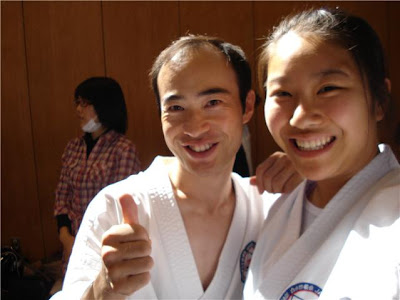Spread the news!
For our sixth year in a row, we are now ready to accept applications for the next intern at the Shiramizu Karate Club in Japan. The internship will run from June 1, 2010 to April 15, 2011, with the possibility of a short extension!
Shiramizu is located one hour from central Tokyo in Sugito City, Saitama Prefecture. It is a full-time dojo with over 450 members run by the popular Takamasa Arakawa Sensei. Shiramizu is one of the most active karate dojos in Japan, and it has warmly accepted previous interns who have all had once-in-a-lifetime experiences.
There is a small furnished apartment for the intern near the dojo. The income earned from teaching English covers all basic living expenses. Interns are encouraged in their free time to expand the list of English classes and private lessons for the program. Shiramizu members meet the new intern at Narita Airport and they also see them off there at the end of their stay.
The application deadline for those wishing to be Intern #6 is January 15, 2010, but applications received earlier will be given preference.
While the internship accepts applications from anyone regardless of karate experience or style, JKF Wadokai members will be given preference. In previous years, non-Wadokai members have been chosen.
The main determining factors we are looking for are someone who exudes positive enthusiasm and someone who would like to get involved in as much as possible here in Japan! Plus they must be able to commit to the full internship time period, no exceptions!
Teaching English conversation classes are included as part of the internship so that the intern can make enough money to cover living expenses. Applicants therefore must have a native-English speaker's level.
Minimum requirements:
Age: Between 20-30 years old (the legal adult age in Japan is 20yrs old therefore the internship is set from age 20).
Education: Minimum English-as-the-main-language high school graduate. An applicant with some post-secondary education of any type is preferred with recent university/college graduates being ideal.
English language teacher training is an asset. If an applicant has none, then at least they should be willing to take a short (1-2 days) ESL instructor's course prior to coming to Japan.
Work experience: Experience working with children in some way. Actual English teaching or tutoring experience is a bonus.
Karate experience: Any level of karate experience is ok. As mentioned previously, when two applications are similar, Wadokai members will be given preference.
If the chosen applicant is from another style, they may go to another dojo of the same style in Japan, but they have to commit to going to the Shiramizu dojo to train twice a week to maintain the internship program's interaction with Shiramizu members.
The intern does not have to compete in every available tournament, but they should make an effort to compete as much as possible. There are about 6 main tournaments a year the intern should register for through Shiramizu.
Previously visited Japan: Due to Japan being quite different from other countries, it will be an asset for applicants who have visited or lived in Japan.
Visa: There are two options.
1) If the chosen applicant is from a country in the
working holiday program (English-speaking countries are Canada, the United Kingdom, New Zealand, Australia, Ireland), then that visa will be used. The Shiramizu Director will guide the applicant through the process as the applicant applies by themselves to their nearest Japanese embassy or consulate.
2) If the chosen applicant is not from a country in the working holiday program (for example, the USA or South Africa), then Shiramizu will apply for a
cultural visa (bunka katsudo visa) for the new intern and upon receiving a cultural visa letter of eligibility from Japanese immigration, the dojo will mail this document to the applicant to take to their nearest Japanese embassy or consulate. Then the embassy/consulate will make the final determination whether or not to issue the visa, and if everything is ok, it will be stamped into their passport prior to coming to Japan.
Both visas take a few days to process. Upon being stamped into the applicant's passport, the applicant needs to enter Japan within 3 months to activate it or it will expire.
Final application procedure: While highly unlikely, due to the chance the chosen applicant may be denied a visa for some unknown reason, a runner-up for the internship will also be picked. The original chosen applicant must apply for their visa just under the 3 month mark prior to coming to Japan, so that if they are denied, the runner-up can be informed with enough time to prepare to apply for a visa while getting their things in order to come to Japan.
This procedure makes it fair for everyone applying, while also keeping the internship going. There are many responsibilities this internship has, for example the various English teaching commitments, so it is important the internship program itself doesn't fail to keep these commitments going.
Anyone seriously interested in applying to be the next intern can email us a request for the application package which explains everything in detail.
We look forward to hearing from interested applicants soon! The sooner people apply, the sooner interviews and reference checks can be done as early applicants will receive preference.
Sincerely,
Richard, Internship Director
email: karateintern at gmail dot com














































